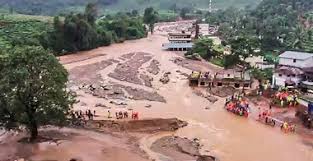
Eight months after the catastrophic landslide that struck Kerala’s Mundakkai and Chooralmala regions, the once-bustling valley remains eerily silent, its streets devoid of residents and tourists. Survivors visit only to pay tribute to lost loved ones, while the abandoned homes and rubble-covered landscape stand as grim reminders of the disaster that unfolded on July 30 last year.
Survivors Struggle with Loss
Suhara Joseph, 56, was among those who lost everything to the landslide. Seated under the shade of a shop in Chooralmala, she stared at the ruins of what was once her home. “I am least concerned about the house and the properties we lost, but I can’t get over the fact that the people who were so close to us are all gone,” she told PTI, her voice choked with emotion.
Suhara survived only because she was at a hospital with her husband at the time. Tragically, all of their neighbors who had visited them the previous night perished in the landslide.
For many like Faisal, another survivor, the disaster site is now sacred ground. “Many of them still remain buried deep somewhere here. This place is like a tomb for our relatives,” he said. Residents fear that opening the area for tourism would disrespect the memories of those lost. A memorandum was submitted to Chief Minister Pinarayi Vijayan requesting a ban on disaster tourism in the region.
A Ghost Town with No Signs of Revival
The Mundakkai and Chooralmala areas, once popular tourist destinations in Wayanad, now resemble ghost towns. The rich greenery has been replaced by barren land covered in mud and boulders. Nights bring a different kind of life—wild animals, including elephants, freely roam the deserted land.
In the three affected wards of Meppadi Panchayat—Punchirimattam, Mundakkai, and Chooralmala—no residents remain, except for one tribal family in Punchirimattam, who refuse to relocate despite government orders.
Houses that narrowly escaped destruction remain locked, their interiors littered with broken furniture, books, and other remnants of lives abruptly upended. Flood marks on walls serve as haunting reminders of nature’s fury.
A local estate worker who has been working in the region for over a decade spoke of the emotional toll. “Every morning, I used to take the road we lost to the landslides. I knew everyone here, and now there is no one. The memories constantly replay in my mind—it is very difficult.”
Economic Ruin for Local Businesses
The landslide has not only displaced residents but also left local shop owners struggling to survive. Once a thriving marketplace, Chooralmala town is now a shadow of its former self.
“Before the disaster, you wouldn’t even find space to park a bike in this town. It was so lively, and I was living off the rent I received from this three-storey building,” said a shop owner. Now, he sells tender coconuts and pickled vegetables from a small section of the damaged building, desperately trying to support his family.
Around 53 shop and building owners have been left without a source of income. Despite submitting multiple memorandums to the Revenue Minister and the Chief Minister, they have yet to receive a response.
Restricted Access and Uncertain Future
The Kerala government has enforced strict restrictions on entry to the landslide-affected zones. Only pass holders—government officials, police personnel, and select individuals from other parts of Chooralmala—are allowed to cross the Bailey bridge leading to Mundakkai and Punchirimattam.
With no sign of revival and the scars of disaster still fresh, the future of these once-vibrant communities remains uncertain. Survivors continue to grapple with the trauma of loss, while business owners fight for financial relief. For now, Mundakkai and Chooralmala remain frozen in time, a silent testament to the worst landslide Kerala has ever witnessed.
Sources By Agencies




